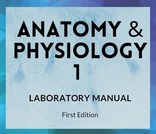
Laboratory manual for undergraduate Anatomy & Physiology 1
- Subject:
- Anatomy/Physiology
- Biology
- Health, Medicine and Nursing
- Material Type:
- Activity/Lab
- Reading
- Teaching/Learning Strategy
- Textbook
- Author:
- Julie Robinson
- Date Added:
- 06/05/2021

Laboratory manual for undergraduate Anatomy & Physiology 1

Biology is designed for multi-semester biology courses for science majors. It is grounded on an evolutionary basis and includes exciting features that highlight careers in the biological sciences and everyday applications of the concepts at hand. To meet the needs of today’s instructors and students, some content has been strategically condensed while maintaining the overall scope and coverage of traditional texts for this course. Instructors can customize the book, adapting it to the approach that works best in their classroom. Biology also includes an innovative art program that incorporates critical thinking and clicker questions to help students understand—and apply—key concepts.
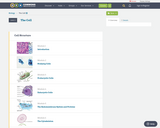
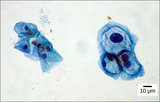
By the end of this section, you will be able to:Describe the role of cells in organismsCompare and contrast light microscopy and electron microscopySummarize cell theory
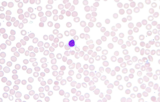
This video shows scanning a Wright's stained blood smear slide with pauses to view leukocytes. The video was taken at 630X under a brightfield microscope. This video is compatible with a laboratory lesson in which students observe, categorize, and count leukocytes. More than 100 leukocytes are viewed in this video. Note, this video does not have narration.Video credit: Emily Fox
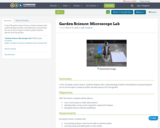
In this 7th grade science lesson, students deepen their understanding of pollen and pollinators by practicing the use of microscopes to observe pollen and bee species from the garden.

This module provides a short introduction to light microscopy using two divergent yeast species, Saccharomyces cerevisiae and Schizosaccharomyces pombe, as subjects. Students examine the yeasts at different phases of their life cycle and compare them to the much smaller bacterium, E. coli. At the end of the module,students should be able to:identify the components of the light microscopestain samples with iodine to improve contrastcorrectly adjust the microscope for different specimensidentify morphological differences between yeast species in both stationary and vegetative phasesThis module is part of a semester-long introductory laboratory course, Investigations in Molecular Cell Biology, at Boston College.

This micrograph was taken at 1000X total magnifcation on a brightfield microscope. The subject is Bacillus cereus cells were grown in broth culture for 48 hours at 30 degrees Celsius. The cells were heat-fixed to a slide and stained with malachite green (endospores) and safranin red (vegetative cells) prior to visualization.Image credit: Emily Fox

This micrograph was taken at 1000X total magnifcation on a brightfield microscope. The subject is Bacillus megaterium cells were grown in broth culture for 5 days at 30 degrees Celsius. The cells were heat-fixed to a slide and stained with malachite green (endospores) and safranin red (vegetative cells) prior to visualization.Image credit: Emily Fox
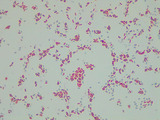
This micrograph was taken at 1000X total magnifcation on a brightfield microscope. The subject is Bacillus subtilis cells were grown in broth culture for 48 hours at 30 degrees Celsius. The cells were heat-fixed to a slide and stained with malachite green (endospores) and safranin red (vegetative cells) prior to visualization.Image credit: Emily Fox
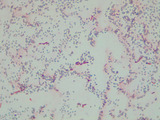
This micrograph was taken at 1000X total magnifcation on a brightfield microscope. The subject is Bacillus subtilis cells were grown in broth culture for 5 days at 30 degrees Celsius. The cells were heat-fixed to a slide and stained with malachite green (endospores) and safranin red (vegetative cells) prior to visualization.Image credit: Emily Fox

This micrograph was taken at 1000X total magnifcation on a brightfield microscope. The subject is Bacillus subtilis cells grown in broth culture overnight at 30 degrees Celsius. The cells were heat-fixed to a slide Gram stained prior to visualization.Image credit: Emily Fox

This micrograph was taken at 100X total magnifcation on a brightfield microscope. The subject is Bacillus subtilis cells grown in broth culture overnight at 30 degrees Celsius. The cells were heat-fixed to a slide Gram stained prior to visualization.Image credit: Emily Fox
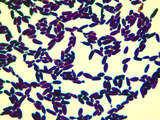
This micrograph was taken at 1000X total magnifcation on a brightfield microscope. The subject is Candida albicans cells grown in broth culture at 30 degrees Celsius. The cells were heat-fixed to a slide and Gram stained prior to visualization.Image credit: Emily Fox
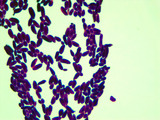
This micrograph was taken at 1000X total magnifcation on a brightfield microscope. The subject is Candida albicans cells grown in broth culture at 30 degrees Celsius. The cells were heat-fixed to a slide and Gram stained prior to visualization.Image credit: Emily Fox
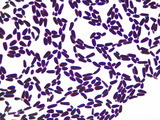
This micrograph was taken at 1000X total magnifcation on a brightfield microscope. The subject is Candida albicans cells grown on YPD agar at 30 degrees Celsius. The cells were heat-fixed to a slide and Gram stained prior to visualization.Image credit: Emily Fox
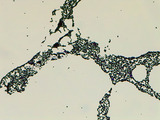
This micrograph was taken at 100X total magnifcation on a brightfield microscope. The subject is Candida albicans cells grown in broth culture at 30 degrees Celsius. The cells were heat-fixed to a slide and Gram stained prior to visualization.Image credit: Emily Fox
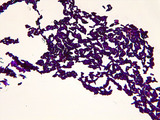
This micrograph was taken at 400X total magnifcation on a brightfield microscope. The subject is Candida albicans cells grown in broth culture at 30 degrees Celsius. The cells were heat-fixed to a slide and Gram stained prior to visualization.Image credit: Emily Fox
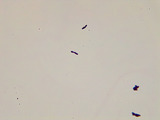
This micrograph was taken at 400X total magnifcation on a brightfield microscope. The subject is Candida albicans cells grown in broth culture at 30 degrees Celsius. The cells were heat-fixed to a slide and Gram stained prior to visualization.Image credit: Emily Fox
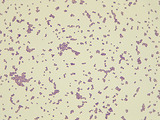
This micrograph was taken at 1000X total magnifcation on a brightfield microscope. The subject is unidentified coccus cells from a contaminant colony grown on nutrient agar at 30 degrees Celsius. The cells were heat-fixed to a slide and Gram stained prior to visualization.Image credit: Emily Fox